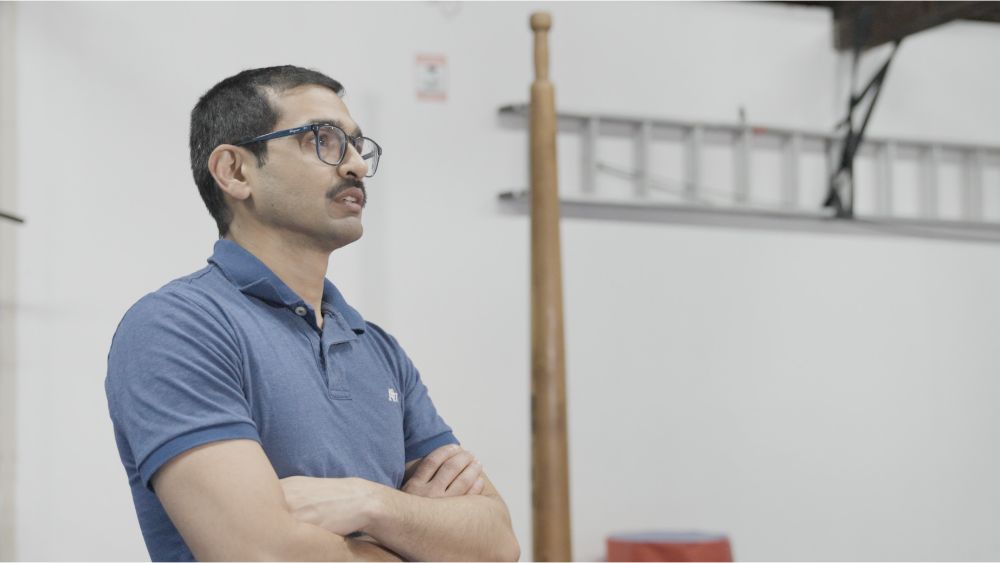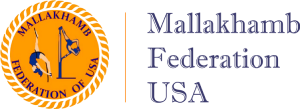Mallakhamb, an ancient Indian sport, might sound unfamiliar, but it’s gaining attention in the world of gymnastics for a good reason. Mallakhamb is basically just like gymnastics but with a twist – or should we say, a pole! Similar to gymnastics postures, Mallakhamb Poses for Gymnastics too has postures and exercises that need to be performed with the help of a pole.
In this blog, we’ll try to understand how could Mallakhamb exercises can be beneficial for Gymnastics routine. We’ll also try to figure out why these exercises are becoming popular among gymnasts looking to upskill their game.
Understanding Mallakhamb
Mallakhamb started as a training method for wrestlers (‘malla’ means wrestler and ‘khamb’ means pole). But over time, it established itself into its own sport, blending somewhat gymnastics like exercises with traditional Indian exercises.
Mallakhamb consists of a sturdy wooden pole firmly planted in the ground. That’s the heart of Mallakhamb. This pole, usually made of Indian rosewood or teak, stands tall, waiting for gymnasts to show off their skills. To make things even more interesting, there are ropes, belts, and grips attached to the pole. These help gymnasts perform jaw-dropping stunning exercises easily and effectively.
Now, let’s come back to today’s Gymnastics. why do you think Mallakhamb could be helpful for gymnasts? Well, Mallakhamb has immense benefits as it’s like a full-body workout that builds your strength, flexibility, and Mallakhamb balance exercises for gymnastics, which are all essential for gymnastics.
Benefits of Incorporating Mallakhamb Exercises for Gymnastics
Incorporating Mallakhamb exercises into your gymnastics training isn’t just about adding a new activity to your routine; it’s about unlocking your full potential as an athlete. Let’s find out the key benefits of Mallakhamb for gymnastics.
Here’s how Mallakhamb can help gymnasts get better in their own sport:
Flexibility Boost
Mallakhamb’s dynamic stretches and twists help gymnasts bend and stretch much flexibly, making those tricky gymnastic moves seem a bit easy.
Strength Builder
With Mallakhamb, body’s every muscle gets a quick warm-up workout. Every climb, twist, and hold on the pole in Mallakhamb helps you build core-strength for Gymnastics. Before you know it, you’ll be powering through routines with ease. Stronger muscles mean more power and control in gymnastics routines.
Balance Master
Balancing on a narrow pole isn’t easy, but that’s what Mallakhamb is all about. It’s like walking a tightrope, but with a twist. Mallakhamb teaches your body to find its center of gravity and stay there, no matter what. And when you bring that newfound balance to the gymnastics mat, you yourself can understand how it will boost your gymnastic routine. Gymnasts who master Mallakhamb’s balance drills can follow any kind of routine with ease.
Mental Focus
Mallakhamb isn’t just about physical strength; it builds mental strength too. Concentration and focus are key when you’re performing gravity-defying stunts on a pole. With practice, you’ll sharpen your mind like a finely-tuned instrument, ready to tackle any gymnastics routine with utmost precision These skills get developed automatically as you continue with Mallakhamb training.
Now that we’ve got a good understanding of Mallakhamb’s benefits, let’s understand how gymnasts can incorporate Mallakhamb into their training routines.
Mallakhamb Exercises for Gymnastics
When it comes to improving your gymnastics skills, Mallakhamb gives a full-body workout. From incorporating Mallakhamb upper body exercises for gymnastics along with Mallakhamb lower body exercises for gymnastics, it provides with a wholesome workout and exercise schedule for gymnasts.
Let’s see five Mallakhamb exercises that cater to beginners, offering a gradual progression towards building strength and muscle endurance.
1. Mallakhamb Pull-Ups
- How to Perform:
- Grip the Mallakhamb pole with both hands, ensuring a comfortable distance between them.
- Hang from the pole, allowing your arms to fully extend.
- Engage your Mallakhamb core and pull yourself up towards the pole, bringing your chest as close as possible.
- Lower yourself back down with control.
- Muscles Targeted:
- Back muscles: Engaged during the pulling motion.
- Biceps: Activated when pulling yourself up.
- Core muscles: Work to stabilize your body.
- Benefits:
- Increased upper body strength.
- Improved grip strength.
2. Mallakhamb Leg Raises
- How to Perform:
- Hang from the Mallakhamb pole with both hands.
- Lift your legs towards your chest, keeping them straight.
- Lower your legs back down in a controlled manner.
- Muscles Targeted:
- Lower abdominal muscles: Worked extensively during the leg lift.
- Hip flexors: Activated during the lifting motion.
- Core muscles: Engaged for stability.
- Benefits:
- Strengthened core.
- Improved hip flexibility.
3. Mallakhamb Push-Ups
- How to Perform:
- Place your hands on the Mallakhamb pole, slightly wider than shoulder-width apart.
- Extend your legs behind you, forming a plank position.
- Lower your chest towards the pole by bending your elbows.
- Push back up to the starting position.
- Muscles Targeted:
- Chest muscles (pectorals).
- Triceps.
- Core muscles.
- Benefits:
- Enhanced upper body strength.
- Improved stability.
4. Mallakhamb Shoulder Stand
- How to Perform:
- Lie on your back with your head towards the Mallakhamb pole.
- Place your hands on the pole and lift your legs up, resting them against the pole.
- Engage your core and lift your hips off the ground, creating a straight line from head to feet.
- Hold the position for as long as you can.
- Muscles Targeted:
- Shoulders.
- Upper back.
- Core.
- Benefits:
- Improved shoulder strength and stability.
- Enhanced balance.
5. Mallakhamb Plank
- How to Perform:
- Assume a push-up position with your hands gripping the Mallakhamb pole.
- Keep your body straight from head to heels.
- Hold the plank position for a specified duration.
- Muscles Targeted:
- Core muscles.
- Shoulders.
- Back.
- Benefits:
- Strengthened core.
- Improved overall body stability.
Sample Mallakhamb and Gymnastics Workout Routine
Let’s now plan a sample workout routine that combines Mallakhamb and gymnastics for maximum impact:
Warm-Up
Start your workout with a Mallakhamb warm-up exercises for gymnastics that gets your blood pumping and your muscles primed for action. Incorporate Mallakhamb movements like swinging on the pole and gymnastics techniques like arm circles and leg swings. This combination warms up your entire body, preparing you for the challenges ahead.
Main Workout
Now it’s time for the real Mallakhamb Gymnastics Workout. Alternate between Mallakhamb and gymnastics drills to keep your body working and your muscles engaged.
Here’s a sample workout to get you started:
- Mallakhamb Climbs
Climb the pole using different grips and techniques to challenge your upper body strength.
- Gymnastics Floor Exercises
Perform a series of floor exercises like cartwheels, handstands, and rolls to work on your agility and coordination.
- Mallakhamb Holds
Hold static positions on the pole, focusing on your balance and stability.
- Beam Work
Practice balancing on a narrow beam, mimicking the challenges of Mallakhamb’s balancing drills.
- Mallakhamb Swings
Swing back and forth on the pole, engaging your Mallakhamb core strengthening exercises for gymnastics and improving your rhythm and timing.
- Bar Mallakhamb Gymnastic Drills
Work on your bar routines, focusing on strength and precision as you transition between different moves.
Relaxing and Stretching
Finish your workout with a gentle cool-down and Mallakhamb stretching exercises for gymnastics sequence to prevent injury and promote recovery. Incorporate static stretches for each major muscle group, holding each stretch for 20-30 seconds to improve flexibility and reduce muscle soreness.
Tips for Integrating Mallakhamb Exercises into Gymnastics Training
Here are some tips to help you seamlessly integrate Mallakhamb exercises into your training routine:
Start with Basic Exercises and Gradually Progress
Rome wasn’t built in a day, and neither are your gymnastics skills. Begin your Mallakhamb journey with simple exercises that focus on building foundational strength and flexibility.
As you grow more comfortable and confident, gradually challenge yourself with more advanced movements. Remember, progress takes time, so be patient with yourself along the way.
Seek Guidance from Experienced Trainers or Coaches
Mallakhamb might be new to you, and that’s okay! Don’t hesitate to reach out to experienced trainers or coaches who are familiar with both Mallakhamb and gymnastics.
They can provide valuable insights, tips, and personalized guidance to help you navigate your Mallakhamb journey safely and effectively.
Listen to Your Body and Avoid Overexertion
It’s easy to get caught up in the excitement of trying something new, but it’s important to listen to your body and know your limits.
Avoid pushing yourself too hard or overexerting your muscles, as this can lead to injuries. Pay attention to any signs of fatigue or discomfort, and take breaks as needed. Your body will thank you for it in the long run.
Consistency is Key
Like any skill, mastering Mallakhamb takes practice and consistency. Make Mallakhamb exercises a regular part of your training regimen, incorporating them into your workouts on a consistent basis.
Whether it’s a few times a week or every day, staying consistent will help you see progress and improvements in your gymnastics performance over time.
Conclusion
As we come to the end of our journey exploring Mallakhamb exercises for gymnastics, you might by now have understood, Mallakhamb benefits for Gymnastics aren’t just physical. It’s about embracing a new approach to training and discovering the joy of pushing your limits.
So, whether you’re a seasoned gymnast or just starting out, I encourage you to explore Mallakhamb as a complementary training method for gymnastics. You’ll be amazed at the difference it can make in your athletic performance and overall fitness.
Like two puzzle pieces fitting perfectly together, Mallakhamb improves the strengths of gymnastics, creating a harmonious blend of power, grace, and agility.
FAQs
1. How does Mallakhamb relate to gymnastics?
Mallakhamb complements gymnastics by enhancing flexibility, strength, balance, and mental focus, making it an ideal addition to gymnastics training.
2. Are Mallakhamb exercises suitable for beginners in gymnastics?
Yes, Mallakhamb exercises can be adapted for beginners in gymnastics. Starting with basic exercises and gradually progressing to more advanced movements allows beginners to build strength, flexibility, and coordination over time.
3. How can Mallakhamb exercises benefit experienced gymnasts?
Mallakhamb exercises offer experienced gymnasts’ opportunities to refine technique, improve flexibility, and strengthen muscles in different ways than traditional gymnastics training.
4. Is it necessary to have access to a Mallakhamb pole to incorporate these exercises into my gymnastics training?
While having access to a Mallakhamb pole is ideal, many Mallakhamb exercises can be modified or adapted to use gymnastics equipment or other alternatives. Consult with a knowledgeable coach or trainer to find suitable substitutions for your training environment.
5. How often should I incorporate Mallakhamb exercises into my gymnastics training routine?
Consistency is key when incorporating Mallakhamb exercises into your gymnastics training. Aim to include Mallakhamb drills in your routine regularly, balancing them with your existing gymnastics workouts to achieve optimal results in strength, flexibility, and overall performance.


